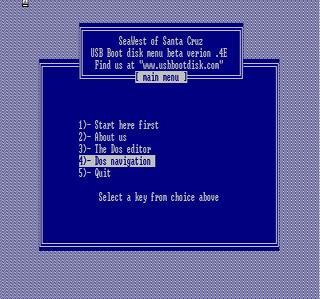|
Here is a list of project possibilities that are in the works for you geeks out there and I guess that normal people are welcome to. Remember it is the making of these programs below and many more that makes it posable for the rest of this site to be simple to use. Not all of them will make it to this site for one reason or another. Some of the projects will get farmed out to some one and never get completed. Maybe lack of interest and so on and so forth. The first project was the FreeDOS project. It was done in three steps as an intro to you. Now that you know how it is done, you should be able to put this project together in a matter of minutes from start to the finished USB Drive.
The FreeDOS FAT system
FreeDOS can run in a FAT12, FAT16, or FAT32 file system and is very different then the Windows NTFS file system. Windows can read and write FAT type file system for the most part, FreeDOS can’t the NTFS file system. Its totally invisible to FreeDOS . With a little tweeting the files used in the first FreeDOS project could run out of a windows dos shell, with out the aid of FreeDOS. So. What is the point of using another type of operating system. Not everything that runs in FreeDOS will run is a windows shell. Below are projects the won’t run out of windows.
assingment 7: called Vid_dump. I would like to grab a copy of the first video screen that pops up before the OS write over it. The vid_dump program does just that.Vid_dump was designed to run off of floppy only and needs to be rewritten for the USB Drive. No way are you going to get windows to do a trick like this one. To the right is a picture of a video capture of a Bios splash screen. This one was done using a floppy drive. As you can see this computer was to old to support USB booting. Some source code will be made available. soon? The vid_dump program does just that.Vid_dump was designed to run off of floppy only and needs to be rewritten for the USB Drive. No way are you going to get windows to do a trick like this one. To the right is a picture of a video capture of a Bios splash screen. This one was done using a floppy drive. As you can see this computer was to old to support USB booting. Some source code will be made available. soon?
assignment 8: called mbr_tabl. Just grab the table form the MBR and display it so that it is readable. USB drives often place their partions some where in the middle of the drive. We may need this offset in order to make an ISO file. Some source code will be made available. soon?
Assignment 11: called sc_edit. Is a very simple one screen full text editor. Can be ported to other operating systems. it’s main use can be used in Ms-dos ver. 1 to ms-dos ver. 3 because the DOS editor “edline” sucks! Some source code will be made available. soon?
Assignment 13: call list. list just list text files. uses arrow keys to move around in a large text files. Some source code will be made available. soon?
Assignment 14: called qt_edit. This is a full screen word editor. Uses FCB stuff for reading and writing files. So it will work with all ms-dos versions and FreeDOS and sone other DOS’s. Windows doesn’t support FCB stuff. Some source code will be made available. soon?
Assignment 19: called Flopper-II. Some very old 80’s software will only run on floppy drives. These floppy drives have very small drive sizes and won’t work on most USB drives. So formatting a USB drive as a floppy disk is next to impossible for most new computers and USB drives Flopper-II solves this problem. Flopper-II is not an emulator. So your programs don’t run slow.
debug, Hexedit, Ezdos, Dos-0 dinkit and the list goes on.
But enough for now
|